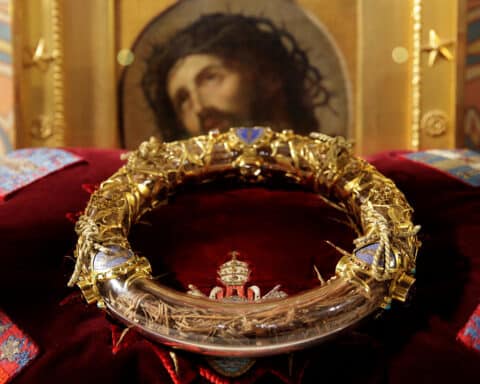The cathedral in Aachen, Germany, is home to a reliquary called the Marienschrein. The Marienschrein does not contain the typical bones of a revered saint. Instead, tradition holds that the reliquary houses, among other oddities, the swaddling clothes of the Infant Jesus.
A destination for pilgrims
Tradition claims that these relics came from Jerusalem through a holy empress named Eudocia. Similar to St. Helena and the story of the true Cross, Eudocia took sacred relics back to her home in Constantinople where she dispersed them among a number of churches. Several centuries later, Charlemagne brought this particular set of holy relics to Aachen, and they were first displayed publicly in 809.
In the 14th century, pilgrims were drawn to Aachen to venerate the Baby Jesus’ swaddling clothes. This may be in part due to the rumor that the cloth they were made of was previously St. Joseph’s sock. A legend says that St. Joseph offered his stocking to Mary in lieu of swaddling clothes upon the sudden birth of Our Lord.

Regardless of its origin or lore, crowds of pilgrims flocked to Aachen to venerate this relic over the ages. In spite of their obscurity, these simple strips of cloth carry deeper insight into the person of Jesus, the Holy Family and Christ’s salvific mission.
Symbolic of the covenant
In Ezekiel 16:4, the Lord compares Israel to an abandoned child, unwashed and “not rubbed with salt or wrapped in swaddling clothes.” This passage preludes Israel’s lack of faithfulness to the Lord, despite his love for her, and the divine punishment she will endure as a result. The chapter ends in a promise that the Lord himself will remember his covenant with Israel and a promise of redemption.
Ezekiel’s mention of salting and swaddling a baby is strange to modern ears but was deeply significant in ancient Jewish life. A young girl would embroider swaddling clothes during her engagement. On her wedding day, the priest would wrap the swaddling clothes around the husband and wife’s hands to symbolize their unity. After the birth of their first child, the couple would rub salt onto the baby and wrap it in these same swaddling clothes. Salt signified covenantal relationship (it was also used in Temple sacrifices) and the clothes symbolized faithfulness, purity and adoption.
It is safe to infer that Mary and Joseph would have performed these Jewish customs when Jesus was born. In contrast to the analogy in Ezekiel, Jesus was likely cleaned and salted after birth, symbolizing his own faithfulness and covenant with God. It also foretells the covenant he would restore between the Father and his fallen people. Additionally, swaddling would signify Joseph’s fatherly adoption of Jesus, dispelling any rumors that Jesus was an illegitimate child.
Jesus, the sacrificial lamb
When the angel appeared to the shepherds, he proclaimed that the baby wrapped in swaddling clothes would be “a sign” (Lk 2:12). However, if most Jewish mothers swaddled their babies, how could this possibly be a significant “sign”?
Near Bethlehem, there is a tower called Migdal Eder (also known as “Tower of the Flock”) where sheep were raised for sacrificial offerings in the Temple. Some scholars believe that the shepherds at the Nativity were Levitical shepherds raising lambs at Migdal Eder. These same shepherds likely swaddled lambs at birth to ensure they remained clean and their limbs didn’t become distorted, as all sacrificial lambs were required to remain unblemished. The shepherds would have seen a baby bound like their own lambs were. Jesus, the Lamb of God, was a lamb born for a specific sacrifice, for the salvation of the world.
The swaddling clothes may seem like strange items to revere. But stranger still, and certainly more profound, is what these bands of cloth proclaim: The baby born in Bethlehem is our pure and faithful God, the sacrificial lamb, the savior of the world.





